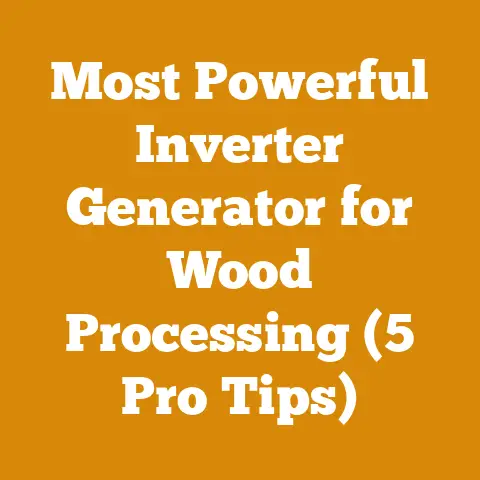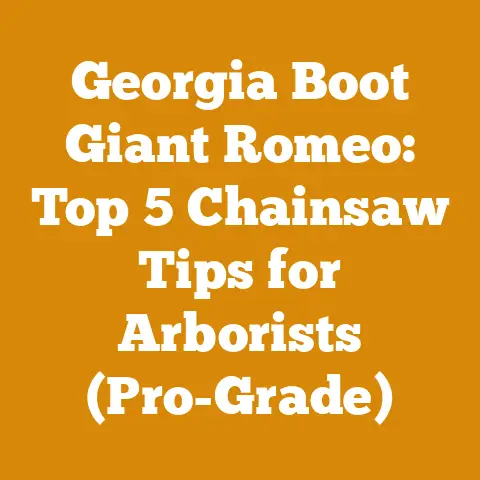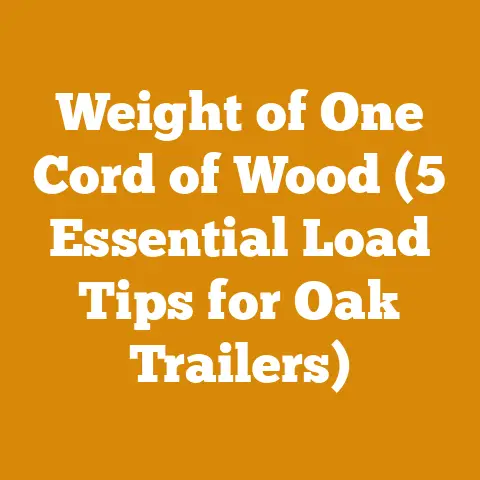Tree Trunk Removal Machine: Best Stump Grinders for Newbies (Pro Tips)
Understanding the Stump Grinding Landscape
Before we get our hands dirty, let’s lay the groundwork. Stump grinding is the process of mechanically removing a tree stump by chipping it away into small pieces of wood and soil. This is far more efficient and less labor-intensive than digging out the entire root system.
Why Grind Stumps?
- Aesthetics: Let’s face it, stumps aren’t pretty. Removing them dramatically improves your property’s curb appeal.
- Safety: Stumps can be tripping hazards, especially for children and the elderly.
- Pest Control: Decaying stumps attract insects like termites and carpenter ants, which can then infest your home.
- Land Use: Removing stumps frees up space for landscaping, gardening, or building projects.
- Preventing Regrowth: Some tree species stubbornly send up new shoots from the stump, which grinding effectively eliminates.
Key Terms and Concepts
- Stump Grinder: A specialized machine with a rotating cutting wheel equipped with carbide teeth, designed to chip away at wood.
- Cutting Wheel: The heart of the stump grinder, responsible for the actual grinding action.
- Carbide Teeth: Extremely hard and durable teeth that do the cutting. They can be replaced as they wear down.
- Swing Arc: The range of motion the cutting wheel can cover, determining how wide an area you can grind without repositioning the machine.
- Grinding Depth: How far below the ground surface the machine can grind. This is important for complete removal and future landscaping.
- Self-Propelled: A stump grinder that can move under its own power, making it easier to maneuver.
- Towable: A stump grinder designed to be towed behind a vehicle.
- Green Wood: Freshly cut wood with a high moisture content.
- Seasoned Wood: Wood that has been allowed to dry, reducing its moisture content. This is more relevant for firewood, but knowing the difference can help you understand how easily a stump will grind. Greener stumps tend to be easier to grind, believe it or not, due to their softer texture.
Choosing the Right Stump Grinder: A Beginner’s Guide
Selecting the right stump grinder is crucial for a successful and safe project. Several factors come into play, including the size and number of stumps you need to remove, your budget, and your physical capabilities.
Types of Stump Grinders
- Handheld Stump Grinders: These are the smallest and most affordable option, ideal for very small stumps (less than 6 inches in diameter) and occasional use. They are lightweight and easy to maneuver but require significant physical effort. My Experience: I once tried using a handheld grinder on a 10-inch oak stump. After an hour of struggling, I realized I was fighting a losing battle and rented a larger machine.
- Walk-Behind Stump Grinders: These are more powerful than handheld models and suitable for small to medium-sized stumps (up to 12-18 inches in diameter). They are self-propelled, making them easier to operate, but still require some physical exertion. These come in two styles:
- Rear-Wheel Drive: These are more common. They are cheaper and easier to maneuver on flatter surfaces.
- Tracked: These are more expensive, but they excel on uneven or sloped terrain, making them a great choice for challenging landscapes.
- Towable Stump Grinders: These are the workhorses of the stump grinding world, capable of tackling large stumps (over 18 inches in diameter) with ease. They are typically powered by gasoline engines ranging from 20 to 40 horsepower and require a vehicle with a trailer hitch for transportation.
- Hydraulic Stump Grinders: These are typically commercial-grade machines and are the most powerful and efficient. They offer precise control and can handle the toughest stumps. They’re usually mounted on a skid steer or excavator.
Factors to Consider
- Stump Size: Measure the diameter of the largest stump you need to remove. This will help you determine the appropriate grinder size.
- Number of Stumps: If you have multiple stumps to grind, a more powerful and efficient machine will save you time and effort.
- Terrain: Consider the terrain where the stumps are located. If it’s uneven or sloped, a tracked or towable grinder with good traction is essential.
- Budget: Stump grinders range in price from a few hundred dollars for handheld models to several thousand dollars for towable and hydraulic machines. Consider renting a machine if you only need it for occasional use.
- Physical Capabilities: Operating a stump grinder can be physically demanding. If you have back problems or other physical limitations, choose a self-propelled or hydraulic model that requires less exertion.
- Power Source: Most stump grinders are powered by gasoline engines, but electric models are also available. Electric grinders are quieter and produce no emissions but are typically less powerful and have shorter run times.
Specific Tool Specifications
- Handheld Stump Grinders: Typically use a 2-4 horsepower electric motor or a small gasoline engine. Cutting wheel diameter ranges from 6-8 inches.
- Walk-Behind Stump Grinders: Gasoline engines ranging from 13-20 horsepower. Cutting wheel diameter ranges from 12-16 inches.
- Towable Stump Grinders: Gasoline engines ranging from 20-40 horsepower. Cutting wheel diameter ranges from 16-20 inches.
- Carbide Teeth: Look for carbide teeth made from high-quality materials for maximum durability and cutting performance. Replace teeth when they become dull or damaged. A dull tooth is more dangerous than a sharp one.
Case Study: My First Stump Grinding Project
I vividly remember my first stump grinding project. I had a massive oak stump in my backyard, a remnant of a tree that had been felled by a storm. Armed with a rented towable stump grinder (27 HP Kohler engine, 18-inch cutting wheel), I felt like a superhero. However, I quickly realized that stump grinding is not as easy as it looks. The machine bucked and vibrated, and I struggled to control it. After a few hours of trial and error (and a few near misses), I finally managed to grind the stump down to the desired depth. The experience taught me the importance of proper technique, safety precautions, and choosing the right machine for the job.
Safety First: Essential Precautions for Stump Grinding
Stump grinding is inherently dangerous. The high-speed rotating cutting wheel can throw debris at tremendous velocity, and the machine itself can be difficult to control. Always prioritize safety and follow these essential precautions:
- Personal Protective Equipment (PPE):
- Eye Protection: Wear safety glasses or a face shield to protect your eyes from flying debris.
- Hearing Protection: Stump grinders are loud. Wear earplugs or earmuffs to prevent hearing damage.
- Hand Protection: Wear heavy-duty work gloves to protect your hands from cuts and abrasions.
- Foot Protection: Wear steel-toed boots to protect your feet from falling objects and the cutting wheel.
- Leg Protection: Wear chaps or heavy-duty pants to protect your legs from flying debris.
- Clear the Work Area: Remove any rocks, debris, or obstacles from the area around the stump. This will prevent them from being thrown by the cutting wheel. Mark a safety zone around the stump and ensure that no people or pets enter the area while you are operating the machine.
- Inspect the Machine: Before each use, inspect the stump grinder for any signs of damage or wear. Check the cutting wheel for loose or damaged teeth, and ensure that all guards and safety devices are in place and functioning properly.
- Read the Manual: Familiarize yourself with the operating instructions and safety precautions outlined in the manufacturer’s manual.
- Start the Engine Safely: Ensure that the cutting wheel is disengaged before starting the engine. Start the engine in a well-ventilated area.
- Maintain a Firm Grip: Keep a firm grip on the machine’s handles at all times. Be prepared for the machine to buck or vibrate.
- Use Proper Technique: Grind the stump in a slow, controlled manner. Avoid forcing the cutting wheel into the wood. Let the machine do the work.
- Be Aware of Underground Utilities: Before grinding, contact your local utility companies to locate any underground utilities in the area. Striking a gas line or electrical cable can be catastrophic.
- Never Operate Under the Influence: Do not operate a stump grinder if you are under the influence of alcohol or drugs.
- Take Breaks: Stump grinding can be physically demanding. Take frequent breaks to avoid fatigue.
- Keep Bystanders Away: Maintain a safe distance between the stump grinder and any bystanders. Flying debris can cause serious injury. I always enforce a 50-foot safety zone around the machine.
- Use Common Sense: If something doesn’t feel right, stop and reassess the situation. Don’t take unnecessary risks.
Step-by-Step Guide to Stump Grinding: From Newbie to Pro
Now that we’ve covered the basics and safety precautions, let’s get down to the nitty-gritty of stump grinding. Here’s a step-by-step guide that will help you tackle your first stump grinding project with confidence.
Step 1: Preparation is Key
- Clear the Stump: Remove any loose bark, rocks, or debris from the stump and the surrounding area. Use a shovel or rake to clear away any soil or mulch that is covering the stump.
- Expose the Root Flare: Use a shovel to expose the root flare, the area where the stump transitions into the roots. This will allow you to grind the stump below ground level.
- Check for Obstacles: Look for any hidden obstacles, such as rocks, metal objects, or underground utilities. Mark the location of any utilities with flags or paint.
- Position the Machine: Position the stump grinder so that the cutting wheel is aligned with the stump. Ensure that the machine is stable and level. If using a towable grinder, make sure it is properly hitched to your vehicle.
Step 2: Starting the Grinder
- Engage the Parking Brake: Engage the parking brake to prevent the machine from moving.
- Start the Engine: Follow the manufacturer’s instructions for starting the engine. Typically, this involves turning the ignition key and pulling the starter rope.
- Warm Up the Engine: Allow the engine to warm up for a few minutes before engaging the cutting wheel.
Step 3: Grinding the Stump
- Position the Cutting Wheel: Position the cutting wheel slightly above the stump.
- Engage the Cutting Wheel: Slowly engage the cutting wheel.
- Begin Grinding: Move the cutting wheel back and forth across the stump in a slow, controlled manner. Overlap each pass slightly to ensure that you grind the entire stump evenly.
- Adjust the Depth: As you grind, gradually lower the cutting wheel to increase the depth of each pass. Avoid forcing the cutting wheel into the wood. Let the machine do the work.
- Grind Below Ground Level: Continue grinding until you have removed the stump to the desired depth, typically 4-6 inches below ground level.
- Grind the Root Flare: Grind the root flare to the same depth as the stump. This will prevent new shoots from growing.
Step 4: Backfilling and Cleanup
- Remove Debris: Remove the wood chips and soil from the hole created by the grinding process.
- Backfill the Hole: Backfill the hole with topsoil or compost.
- Level the Ground: Level the ground with a rake or shovel.
- Seed or Sod: Seed or sod the area to restore the lawn.
Pro Tips for Efficient Grinding
- Sharp Teeth are Essential: Dull teeth will slow you down and make the job more difficult. Replace or sharpen the teeth regularly.
- Grind in Layers: Avoid trying to remove too much material at once. Grind in thin layers for maximum efficiency.
- Work with the Grain: Grinding with the grain of the wood will be easier than grinding against it.
- Use Water: Spraying the stump with water can help to keep the dust down and make the grinding process more efficient.
- Don’t Overheat the Engine: Allow the engine to cool down periodically to prevent overheating.
- Avoid Metal: Be extremely careful to avoid hitting metal objects, such as nails or fencing. Metal can damage the cutting wheel and create dangerous sparks.
Original Insights from My Projects
In one project, I was tasked with removing a series of large oak stumps from a construction site. The stumps were located in a densely wooded area, making it difficult to maneuver the stump grinder. To overcome this challenge, I used a tracked stump grinder, which provided excellent traction and stability on the uneven terrain. I also employed a technique called “contour grinding,” where I followed the natural contours of the ground to minimize the amount of soil that needed to be removed. This saved me a significant amount of time and effort.
Dealing with Difficult Stumps
Not all stumps are created equal. Some stumps are harder to grind than others, due to factors such as wood density, age, and the presence of rocks or other obstacles. Here are some tips for dealing with difficult stumps:
- Hardwood Stumps: Hardwood stumps, such as oak and maple, are more difficult to grind than softwood stumps, such as pine and fir. Use a more powerful stump grinder and sharp teeth to tackle these tough stumps.
- Old Stumps: Old stumps that have been decaying for many years can be brittle and difficult to grind. The wood may be soft and crumbly, making it difficult for the cutting wheel to get a good grip. Try spraying the stump with water to moisten the wood and make it easier to grind.
- Stumps with Rocks: Stumps that contain rocks or other debris can damage the cutting wheel. Carefully inspect the stump before grinding and remove any visible rocks. If you encounter a rock while grinding, stop the machine immediately and remove the rock.
- Stumps with Taproots: Some tree species have a large taproot that extends deep into the ground. This taproot can be difficult to grind. Use a shovel to expose the taproot and grind it in sections.
- Stumps Near Structures: Grinding stumps near buildings, fences, or other structures requires extra caution. Protect the structures from flying debris by covering them with tarps or plywood.
Case Study: Removing a Stump Near a Septic Tank
I once had to remove a large pine stump that was located dangerously close to a septic tank. The risk of damaging the septic tank was significant. To minimize the risk, I used a handheld stump grinder to carefully grind the stump down to ground level. I then used a shovel and pickaxe to manually remove the remaining root system, being careful not to disturb the soil around the septic tank. This was a slow and laborious process, but it was the safest way to remove the stump without damaging the septic tank.
The Economics of Stump Grinding: Rent vs. Buy
Deciding whether to rent or buy a stump grinder depends on several factors, including the frequency of use, the size and number of stumps you need to remove, and your budget.
Renting a Stump Grinder
- Pros:
- Lower upfront cost.
- No maintenance or repair costs.
- Access to a variety of machines.
- Ideal for occasional use.
- Cons:
- Rental fees can add up over time.
- Limited availability.
- May not be able to rent the exact machine you need.
- Time constraints.
Buying a Stump Grinder
- Pros:
- Always available when you need it.
- No rental fees.
- Can be used for multiple projects.
- Potential to generate income by renting it out.
- Cons:
- High upfront cost.
- Requires maintenance and repairs.
- Requires storage space.
- May become obsolete over time.
Cost Analysis
The cost of renting a stump grinder typically ranges from $100 to $300 per day, depending on the size and type of machine. The cost of buying a stump grinder can range from a few hundred dollars for handheld models to several thousand dollars for towable and hydraulic machines.
Example:
- Renting: If you need to grind 5 stumps and it takes you 2 days, the rental cost could be $400-$600.
- Buying: A decent walk-behind stump grinder might cost $2,000. If you only use it once, renting is cheaper. But if you have multiple projects or plan to use it for years to come, buying might be more economical.
My Recommendation:
If you only need to grind stumps occasionally, renting is the most cost-effective option. However, if you plan to use a stump grinder frequently or if you have a large number of stumps to remove, buying a machine may be a better investment.
Stump Grinding Alternatives
While stump grinding is the most common and efficient method for removing tree stumps, other options are available. These alternatives may be suitable for certain situations, depending on your budget, physical capabilities, and the size and location of the stump.
Chemical Stump Removal
Chemical stump removal involves applying a chemical herbicide to the stump to kill the remaining tree tissue. This method is slow and can take several months to completely decompose the stump. However, it is relatively inexpensive and requires minimal physical effort.
- Pros:
- Inexpensive.
- Requires minimal physical effort.
- Cons:
- Slow process.
- May not be effective on all tree species.
- Can be harmful to the environment.
Manual Stump Removal
Manual stump removal involves digging out the stump and root system by hand. This method is labor-intensive and time-consuming, but it is effective and environmentally friendly.
- Pros:
- Environmentally friendly.
- Effective.
- Cons:
- Labor-intensive.
- Time-consuming.
- Requires specialized tools.
Burning the Stump
Burning the stump involves setting the stump on fire and allowing it to burn until it is completely consumed. This method is effective but can be dangerous and is not permitted in all areas.
- Pros:
- Effective.
- Cons:
- Dangerous.
- Not permitted in all areas.
- Can be harmful to the environment.
Natural Decomposition
Allowing the stump to decompose naturally is the simplest but slowest method. Over time, fungi and other organisms will break down the wood, eventually causing the stump to rot away. This process can take several years.
- Pros:
- No cost.
- Requires no effort.
- Cons:
- Very slow.
- Stump remains visible for years.
- Attracts pests.
Maximizing Efficiency: Strategic Insights
Beyond the technical aspects, here are some strategic insights I’ve gained over the years:
- Plan Your Attack: Before you start grinding, take a moment to assess the stump and plan your approach. Identify the areas that will be most difficult to grind and develop a strategy for tackling them.
- Optimize Tooth Sharpness: Regularly check and sharpen your cutting teeth. Sharp teeth not only improve grinding efficiency but also reduce strain on the machine and the operator. I use a diamond grinding wheel to sharpen my teeth, which provides a clean and precise edge.
- Manage Debris: As you grind, the machine will generate a significant amount of wood chips and soil. Use a shovel or rake to clear away the debris periodically. This will help to keep the work area clean and prevent the debris from interfering with the grinding process.
- Leverage Gravity: When grinding on a slope, position the machine so that you are working downhill. This will allow gravity to assist with the grinding process.
- Network with Professionals: Don’t be afraid to reach out to other stump grinding professionals for advice and tips. Sharing knowledge and experiences can help you improve your skills and efficiency. I regularly attend industry trade shows and workshops to stay up-to-date on the latest techniques and technologies.
Dealing with the Aftermath: Wood Chip Management
After grinding the stump, you’ll be left with a pile of wood chips and soil. Here are some options for managing this debris:
- Use as Mulch: Wood chips can be used as mulch around trees and shrubs. They help to retain moisture, suppress weeds, and improve soil health.
- Compost: Wood chips can be added to your compost pile. They provide a source of carbon, which is essential for the composting process.
- Fill the Hole: Use the wood chips and soil to fill the hole created by the grinding process. This will help to level the ground and prevent it from sinking.
- Haul Away: If you don’t have a use for the wood chips, you can haul them away to a landfill or recycling center.
- Offer to Neighbors: Sometimes neighbors are happy to take the woodchips for their gardens.
My Preferred Method:
I prefer to use the wood chips as mulch. It’s an environmentally friendly and cost-effective way to dispose of the debris.
Here are your next steps:
- Assess Your Needs: Evaluate the size and number of stumps you need to remove, your budget, and your physical capabilities.
- Choose a Stump Grinder: Select a stump grinder that is appropriate for your needs. Consider renting a machine if you only need it for occasional use.
- Gather Your PPE: Purchase the necessary personal protective equipment, including eye protection, hearing protection, hand protection, foot protection, and leg protection.
- Clear the Work Area: Remove any rocks, debris, or obstacles from the area around the stump.
- Read the Manual: Familiarize yourself with the operating instructions and safety precautions outlined in the manufacturer’s manual.
- Practice: Start with a small, easy-to-grind stump to get a feel for the machine.
- Stay Safe: Always prioritize safety and follow the essential precautions outlined in this guide.
Stump grinding can be a challenging but rewarding task. With the right knowledge, tools, and techniques, you can transform your property and create a beautiful and functional outdoor space. Good luck, and happy grinding!






